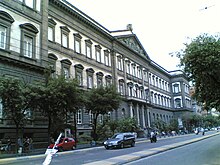University of Naples Federico II
| University of Naples Federico II | |
|---|---|

|
|
| motto | Ad Scientiarum Haustum et Seminarium Doctrinarum |
| founding | June 5, 1224 |
| Sponsorship | state |
| place | Naples , Italy |
| Rector | Gaetano Manfredi |
| Students | 78,324 (2015/16) |
| Employee | 5310 (2014) |
| Website | www.unina.it |
The University of Naples Federico II is a state university in Naples . With a good 78,000 students and 5,300 employees, it is one of the largest universities in Italy.
history
It was founded on June 5, 1224 by Friedrich II , after whom it has been named since 1987. The exact date is, however, fictitious; the message about the foundation, the writing of which is attributed to Petrus de Vinea , does not contain any time information and was probably only distributed in July, as Richard von San Germano reports in his chronicle. However, the existence of the study was only permanently secured after 1240.
In order to decentralize higher education in Italy compared to the University of Bologna and other northern Italian universities, Frederick II - against the will of the then popes - strongly advocated enlightened scientific teaching, which is why the University of Naples became the first university in Europe to do without papal bull taught. This tension during the founding was long characteristic of the study at the University of Naples, and Thomas Aquinas was one of the most famous students and later lecturers in Naples.
So that the newly founded university could establish itself against older universities, Frederick forbade the citizens of the kingdom from studying at foreign universities, especially in Bologna, under threat of physical fines and fines. Other educational institutions within the kingdom were also not allowed to teach the same disciplines as the University of Naples. As a result, a number of said schools were closed.
The higher education policy goal of Frederick II was not limited to the training of suitable civil servants, but included the formation of a broad, learned elite who could consolidate the empire through both legal elements and cultural achievements.
Faculties
There are 13 faculties:
- Agricultural Sciences ( Facoltà di Agraria )
- Architecture ( Facoltà di Architettura )
- Biotechnology ( Facoltà di Scienze Biotecnologiche )
- Business Administration ( Facoltà di Economia )
- Engineering Sciences ( Facoltà di Ingegneria )
- Law ( Facoltà di Giurisprudenza )
- Literature and Philosophy ( Facoltà di Lettere e Filosofia )
- Mathematics , Physics and Natural Sciences ( Facoltà di Scienze Matematiche, Fisiche e Naturali )
- Medicine and Surgery ( Facoltà di Medicina e Chirurgia )
- Pharmacy ( Facoltà di Farmacia )
- Political Science ( Facoltà di Scienze Politiche )
- Veterinary medicine ( Facoltà di Medicina Veterinaria )
- Sociology ( Facoltà di Sociologia )
literature
- Karl Ludwig Hampe : On the founding history of the University of Naples (messages from the Capuan letter collection V) . Heidelberg 1924. (Meeting reports of the Heidelberg Academy of Sciences. Philos.-histor. Class. 14.10.)
- Antonino Sambataro: Federico II e lo "studium" di Napoli. il potere, la cultura e il diritto in età normanno-sveva , Catania 1994.
- Massimo Oldoni: La promozione della scienza. L'Università di Napoli . In: Intellectual Life at the Court of Frederick II Hohenstaufen , ed. v. William Tronzo, Washington 1994, pp. 251-262
- Michele Fatica: Il fondatore dell'università di Napoli . In: Federico II di Svevia. Stupor mundi , ed. v. Franco Cardini , Roma 1994, pp. 119-142.
- Rüegg Walter, History of the University in Europe, Volume 1 Middle Ages . CH Beck, Munich 1993. ISBN 978-3-406-36952-0
Web links
Individual evidence
- ↑ http://www.unina.it/ateneo/organigramma/rettore-e-delegati
- ^ Regesta Imperii V.1 No. 1537; Reg.Imp: V.4 p. 193
- ↑ Archived copy ( memento of the original from October 14, 2013 in the Internet Archive ) Info: The archive link was inserted automatically and has not yet been checked. Please check the original and archive link according to the instructions and then remove this notice.
- ↑ Van Eickels, Klaus / Brüsch, Tania: "Kaiser Friedrich II., Life and Personality in Sources of the Middle Ages". Patmos, Düsseldorf 2000. ISBN 3491691346 . P. 134
- ↑ Nardi, Paolo: Die Hochschulträger, in: Rüegg Walter (Ed.): "History of the University in Europe, Volume 1 Middle Ages". CH Beck, Munich 1993. ISBN 978-3-406-36952-0 . P. 92.
